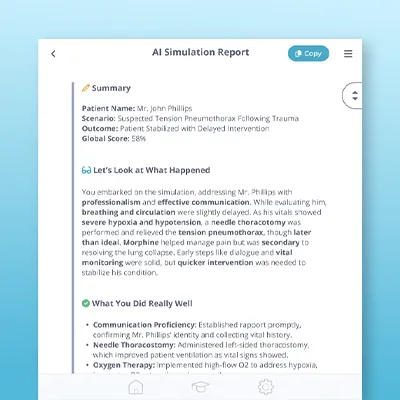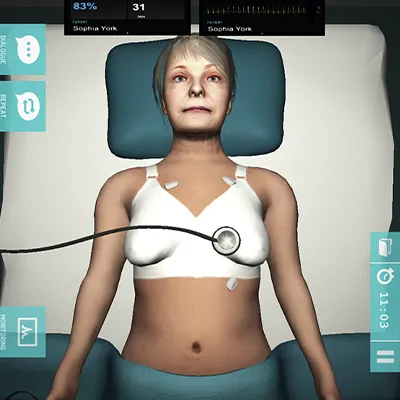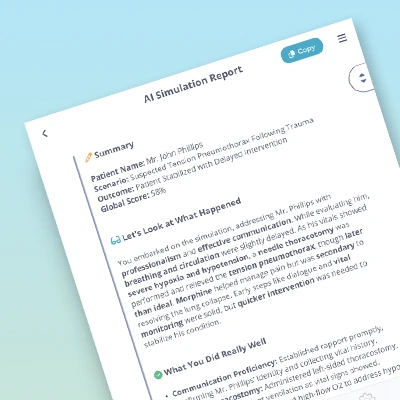A New Structure of Performance in the Feedback Area
Dear Body Interact community,
Aligned with our value of excellence and continuous development to support current and future healthcare professionals and enhance their learning and assessment experiences, we will introduce a new significant enhancement in the Body Interact Virtual Patient Simulator that will improve how learners receive feedback and develop essential clinical skills.
Expected on July 17th, 2025, the Performance Area of all Body Interact scenarios will be presented in a new format, reflecting the key stages of clinical reasoning and patient care. Instead of the current categories – Physical Examination, Diagnostic Activity, and Treatment – feedback will be organized into:

Communication
This first area captures all dialogues with the patient, including history-taking, clarification of symptoms, and education. This area reinforces the ability to communicate clinical information clearly to both the patients and their companions.
Effective communication is essential for gathering accurate data, building trust, enhancing patient compliance, and ensuring shared decision-making in care. It is a foundational skill that supports safety and patient-centered care.
Contributing 20% to the global score, this component covers various aspects of History Taking and Education, reflecting its importance in overall performance.
Assessment
The second area encompasses all activities related to clinical evaluation, such as physical examinations and the ordering or interpretation of diagnostic tests. This area trains learners to recognize patterns, prioritize findings, and connect symptoms to clinical reasoning.
By practicing assessment skills in realistic virtual scenarios, learners gain the confidence to identify early signs of deterioration and make well-informed decisions.
Representing 40% of the global score, this section covers various components of the physical exam and diagnostic tests, highlighting its critical role in clinical judgment.
Management
Lastly, the third area covers all actions taken to address the patient’s condition, including calling for help or escalation, performing interventions, and administering medication. This area develops a learner’s ability to respond safely and effectively, using evidence-based approaches while considering comfort and care continuity.
Management reflects how effectively learners can apply their knowledge in real-time through appropriate actions, helping them build confidence and clinical judgment for future practice.
Accounting for 40% of the global score, this section includes calls, interventions, and medications, highlighting its key role in clinical decision-making.
Based on the learning objectives of each scenario, if a performance component is not included, its score percentage is reallocated to the remaining ones. This ensures the scoring stays balanced and reflects the scenario’s educational goal.
The Purpose Behind the Reorganization
This improved structure highlights several key benefits:
- Simplified feedback by focusing on essential healthcare competencies
- Enhance clinical reasoning by linking actions to outcomes in patient care
- Support all healthcare learners, including students in medicine, nursing, health sciences, and CTE programs, as well as professionals in Continuing Medical Education.
The new framework has already received strong endorsement from our expert consultants:
“I believe the proposed changes will be an excellent addition to the feedback provided to students. This new structure aligns well with the core elements of medical practice, allowing for a more comprehensive evaluation of their skills.”
Jessy Escobar, MD
“The new framework is logical to me.”
Reamer Bushardt, PharmD, PA-C, DFAAP
“Thanks for your efforts in improving the global scores in Body Interact.”
Athena La, MD
We are here to Support You Through the Change
We are confident that this update will deliver even greater value to your learners by helping them not only perform tasks, but also think critically, act with confidence, and provide high-quality care — both now and in the future of patient care.
If you have any questions or wish to explore this update further, we’re happy to help!
New Global Score Structure
- Communication (20%) – includes History Taking, SAMPLE, OPQRST, and Education
- Assessment (40%) – includes Physical Exam, Monitoring, and Diagnostic Tests
- Management (40%) – includes Interventions, Medications, and Calls
Important note: All past and future simulation results will be recalculated to reflect this new scoring model, ensuring consistency and comparability across all data.
By Ana Santa – MSN, APRN
Editorial Manager









